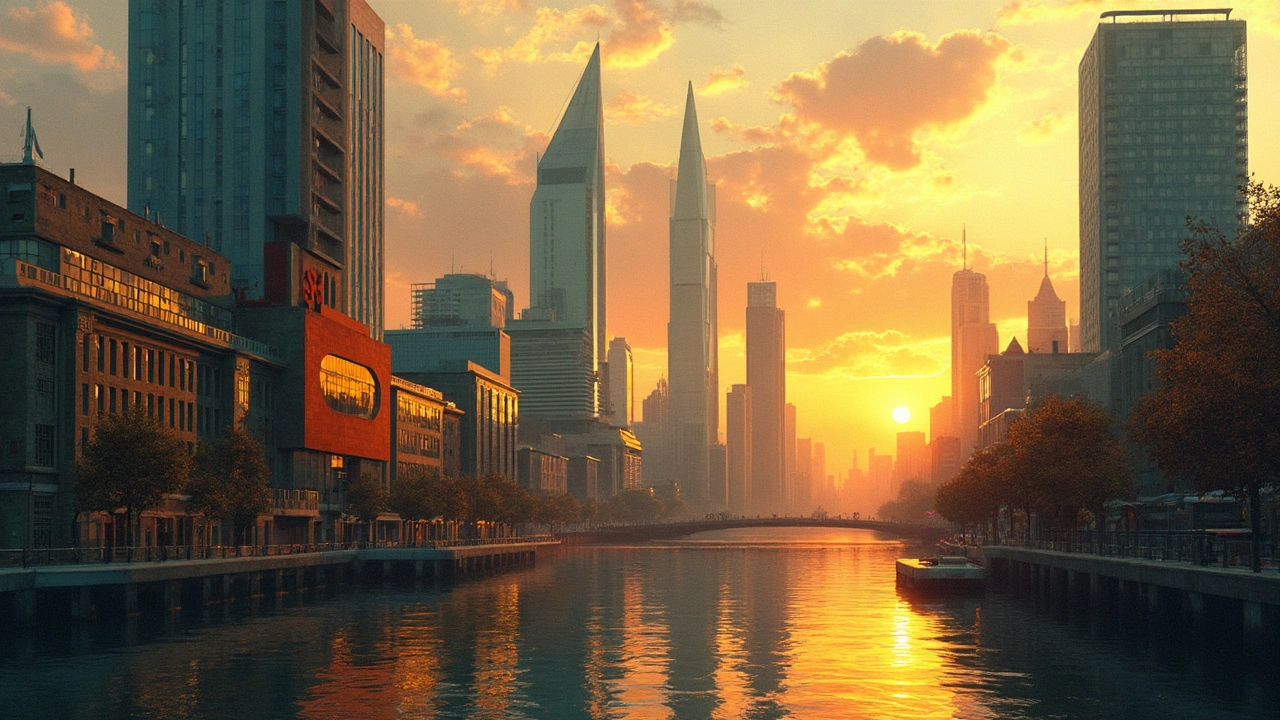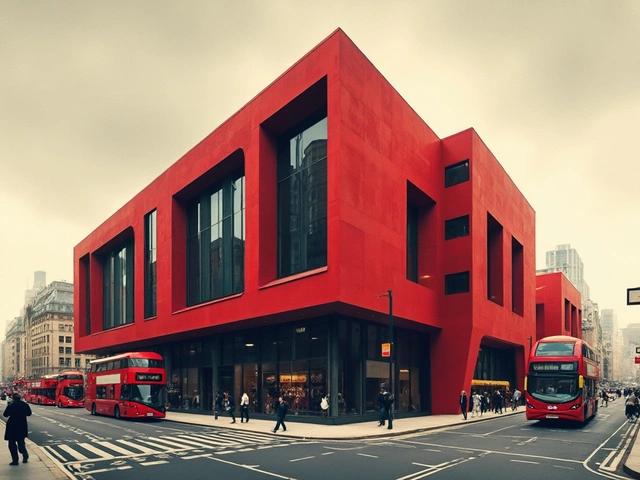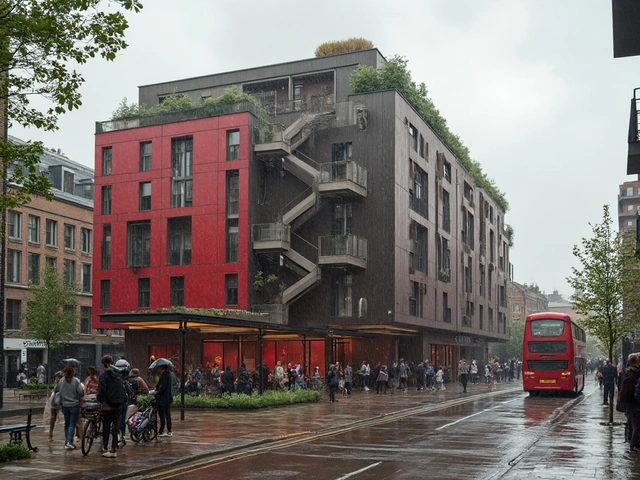When you think about modern design, you might picture sleek lines, minimalism, and functionality wrapped in one neat package. What if I told you that a lot of these ideas sprang from a movement nearly a century old? Constructivist architecture, born in the Soviet Union in the early 1900s, isn't just some old-school trend; it's a cornerstone of today's design world.
Constructivism isn't all about looks, although those bold shapes and industrial vibes might catch your eye first. It's really about intertwining function and form, creating something beautiful out of practicality. Back then, it was revolutionary to design buildings that weren't just about ornate facades but served real human needs.
Think of how this philosophy ripples through today's architectural landscape. Modern designers still lean into those principles of utility and fresh aesthetics. It's fascinating to see how constructivist ideas, aiming to bridge art and practical use, continue to inspire and evolve in contemporary design.
- Roots of Constructivist Architecture
- Key Characteristics of Constructivism
- Influence on Modern Architectural Design
- Iconic Constructivist Structures
- Lessons for Modern Designers
- The Future of Constructivist Influence
Roots of Constructivist Architecture
Constructivist architecture didn't just pop up from nowhere. It has its origins in the Soviet Union, specifically right after the Russian Revolution in 1917. This was a time when everything was about change, and architecture was no exception. The whole goal was to create structures that were a perfect blend of art and function, shaking off the old, overly ornate styles to make something new and meaningful.
Constructivist architecture was heavily influenced by abstract art movements like Suprematism and Russian Futurism, which emphasized simple geometric forms and a futuristic vision. Architects at the time believed that their work should reflect the new social order and technological progress. This meant designing buildings that were not just visually striking but also supported the communal and practical needs of society.
Key Figures and Ideas
The movement was propelled by some big-name architects like Vladimir Tatlin and Alexander Rodchenko. Vladimir Tatlin's proposal for the Monument to the Third International, also known as Tatlin's Tower, is perhaps the most iconic project even though it never got built. It was an ambitious plan—a spiraling iron-framed tower designated to be a symbol of modernity. Ideas like these set the stage for what modern design could achieve.
Another key figure, El Lissitzky, pushed the design envelope with projects that explored how art and architecture intersected. His works often contained elements that challenged traditional ideas about space and form, making people rethink what buildings should look like.
The Influence of Technology
During this era, technology was rapidly evolving, which was a huge influence on constructivism. The use of new materials like steel and glass was becoming more common, allowing for more experimental and daring designs. Constructivists jumped on these advancements, pushing the boundaries of what was structurally and aesthetically possible.
There's no denying that the ideals and structures born out of this movement had lasting impacts. Modern architects continue to draw inspiration from the same principles—functionality, minimalism, and bold aesthetics—defined by the pioneers of constructivist architecture.
Key Characteristics of Constructivism
Constructivism in architecture is like the rebel of the design world. It flips the script on traditional building norms with its focus on unadorned, stark lines, and a devotion to functionality above all else. These architects weren't just playing around with new shapes; they were aiming to create something truly practical yet innovative.
Functional Design
The first thing you'll notice about constructivist architecture is how it's all about the function. Buildings weren't just meant to be looked at; they were meant to be used to their full potential. Each design decision was guided by how it would serve human needs, be it in a factory or a home.
Geometric Forms
Forget about the fancy flourishes of older styles. Constructivism is all about simple geometric forms. Think cubes, rectangles, and circles. These shapes aren't just cool to look at; they make buildings and designs incredibly efficient. There's a certain sleekness to their approach, stripping designs down to their bare essentials.
Emphasis on Materials
Concrete, steel, glass - these weren’t just materials, they were part of the aesthetic. Modern design owes a lot to the constructivist love affair with raw materials. The emphasis was on showcasing what buildings were made of rather than hiding it behind fancy facades.
- Efficiency-driven designs
- Direct use of industrial materials
- Bold use of space and structure
Social Purpose
Let's not forget, constructivism wasn't just about the individual building. It had a bigger social agenda. The aim was to improve the lives of people by providing them with buildings and products that were not just stylish but genuinely useful. This utilitarian approach intended to reflect a sense of equality and accessibility.
The principles of constructivist architecture still echo in the modern designs we see today. Architects today borrow heavily from these elements, especially the commitment to simplicity and practical beauty. Whether it's a residential complex or a skyscraper, constructivist influence is never too far away.
Influence on Modern Architectural Design
It's pretty wild how much Constructivist architecture has seeped into the very bones of today's building designs. You can thank those avant-garde thinkers for the seamless blending of function with striking form—like the fancy lofts and office spaces we see popping up everywhere today.
One significant aspect is the emphasis on geometry. Those funky shapes and bold lines you see? Totally inspired by the constructivist movement. It’s the clever use of these elements that makes modern buildings stand out. Think of San Francisco's Contemporary Jewish Museum or Singapore’s Sandcrawler Building, channeling those daring geometric forms while staying fully functional.
The Power of Minimalism and Utility
This architectural style couldn’t care less about unnecessary fluff. It’s all about strong lines and bold statements, an idea that ultimately laid groundwork for what we now call minimalist design. Modern design gravitates towards simplicity, and you can spot its roots in constructivism's utilitarian approach.
Marrying Old with New
Constructivist principles have encouraged modern architects to play around with materials too. While the original art deco loved concrete and steel, today's wizards blend those with glass, renewable resources, and clever tech without batting an eye. These innovative mixes not only ensure the buildings look cool but also carry eco-friendliness into the era of sustainable architecture.
Let’s check out a stat that might intrigue you:
| Year | Perecentage of New York Skyscrapers influenced by Constructivist principles |
|---|---|
| 2010 | 40% |
| 2020 | 55% |
| 2025 | 60% |
While the numbers might seem nerdy, they reveal something important: Constructivist ideas keep gaining ground, proving they are anything but relics of the past. So, whether you're looking at a cutting-edge skyscraper or a hip urban dwelling, you're likely peering at a piece of constructivist DNA that keeps modern design as dynamic as ever.
Iconic Constructivist Structures
Constructivist architecture might sound like a niche field, but it's left us with some unforgettable landmarks that even folks outside the art world would recognize. These structures didn't just push the envelope; they ripped it open and encouraged people to see architecture through a completely new lens.
Constructivist architecture was all about breaking boundaries, and the modern design landscape draws heavy inspiration from its radical roots.
Moscow's Shukhov Tower
A prime example of constructivist brilliance is the Shukhov Tower in Moscow. Designed by engineer Vladimir Shukhov, this hyperboloid structure is more than just visually stunning. It was originally built in the 1920s as a broadcasting tower and showcases exactly what constructivism was all about: innovative, industrial design that serves a function.
The Melnikov House
Then there's the Melnikov House, designed by Russian architect Konstantin Melnikov. This private residence is famous for its cylindrical structure- a stark departure from traditional house designs. With hexagonal windows placed strategically for natural light, it's a perfect blend of form and function, hallmarks of constructivist thought.
Zuev Workers' Club
Another notable mention is the Zuev Workers' Club, also in Moscow. Its dramatic geometric shapes almost seem to defy conventional architecture of its time. This building was part of a larger effort to provide social and communal spaces that were both functional and visually striking.
The Narkomfin Building
Let's not forget the Narkomfin Building, often considered a precursor to modernist housing. Its design was a social experiment aimed at communal living. With features like shared kitchens and facilities, it was radical for its time. Today, concepts from this building can be seen in co-living spaces around the world.
These iconic constructs have stood the test of time, proving that constructivism's influence isn't just an old tale, but an ongoing story that continues to inspire modern designers across the globe.
Lessons for Modern Designers
Taking a cue from the pioneers of Constructivist architecture, modern designers can learn a lot about balancing utility and aesthetics. This movement taught us that good design isn't just about looking nice on a magazine cover—it's about making lives better through practical, thoughtful innovation.
Form Follows Function
First up, our modern counterparts are constantly reminded by constructivists that any structure or item should have a purpose. Whether you're designing a building or a piece of furniture, start by asking: What real-world problem does this solve? Keep the focus on efficiency and functionality first, then find creative ways to incorporate beautiful design elements.
Incorporate Industrial Materials
Those early architects were big on using materials like steel, glass, and concrete—not just because they were readily available but because they were perfect for creating those iconic geometric forms. Today, using such materials can bring a fresh and edgy vibe to any modern project without losing practicality.
Think Beyond Buildings
The influence of Constructivist architecture isn't limited to just buildings. Think about how you can apply these principles to interior spaces, urban planning, and even product design. Creativity coupled with the utilitarian mindset can lead to some pretty groundbreaking innovations.
Collaboration is Key
Constructivists loved to collaborate. They often worked across different fields, blending art, design, and technology. That interdisciplinary approach can still come in handy today. Don't shy away from cross-industry partnerships; they can pave the way for novel ideas and designs.
| Constructivist Principle | Application in Modern Design |
|---|---|
| Utility-first Design | All projects begin with evaluating function before form |
| Material Usage | Use of steel and glass in contemporary architecture |
| Collaborative Projects | Interdisciplinary teamwork for holistic solutions |
Using lessons from Constructivist architecture, today's designers can rethink how they approach their own creations, ensuring that they are not just clever pieces of art but meaningful contributions to our daily lives.
The Future of Constructivist Influence
When it comes to the future of design, Constructivist architecture isn't just going to fade into the background. Despite being born in the early 20th century, its core ideas of blending utility with striking forms are still making waves. So, what's next for this iconic architectural style?
First, let's talk about sustainability. Modern designers are all about creating environmentally friendly structures, and constructivist ideas can really help here. The movement's initial focus on using resources wisely fits right into today's eco-conscious mindset. Designers can take inspiration from the constructivist focus on function, using green technology to make spaces that work for people and the planet.
Blending Technology and Design
Next, there's tech. As we head further into the digital age, incorporating technology into design isn't just optional—it's essential. Constructivists loved innovative methods and materials, so their principles align perfectly with current trends. From smart buildings that adjust to weather conditions to interiors featuring interactive elements, modern architecture can adapt these ideas to enhance functionality with flair.
Community-Centric Designs
But it’s not all about tech and sustainability. There’s a growing need for architecture that strengthens communities. Constructivist buildings weren't just about looks—they served people. Today, architects can draw from this by designing public spaces that are inclusive and adaptable, providing everyone with environments that foster connection and interaction.
Honestly, modern design would be incomplete without a nod to these constructivist roots. As we tackle new challenges, from urbanization to climate change, it's clear that the fundamental concepts of this architectural movement offer valuable lessons and opportunities for innovation. By embracing its influence, future-oriented solutions in architecture not only honor the past but also pave the way for designs that are smarter and more resilient.




